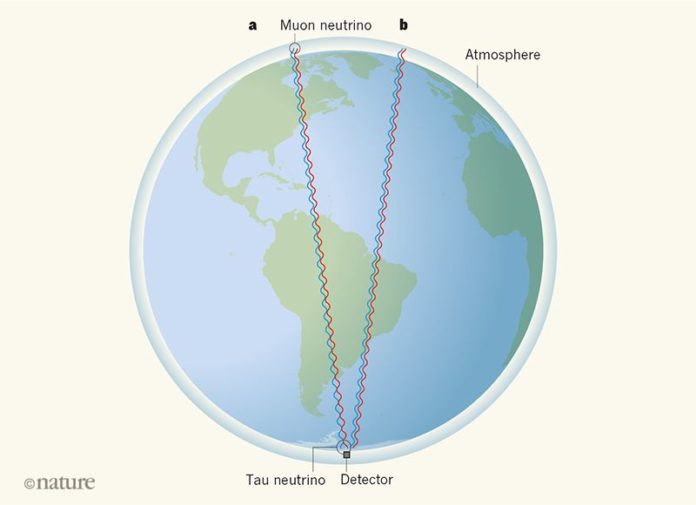Lorentz symmetry is a fundamental spacetime symmetry underlying both the standard model of particle physics and general relativity. This symmetry guarantees that physical phenomena are observed to be the same by all inertial observers.
Physicists, for the most part, accept that Lorentz invariance holds precisely. Nonetheless, in the late 1990s, the standard started to be efficiently challenged, to a great extent due to the possibility that it was broken slightly in proposed theories of fundamental physics, such as string theory.
In the course of recent decades, scientists have tried Lorentz invariance in objects extending from photons to the Moon.
Now, the IceCube Collaboration uses neutrinos seen in the world’s largest particle detector to scrutinize another cornerstone of physics: Lorentz invariance. The main goal is to determine comparatively scarce neutrinos that are produced during some of the Universe’s most violent astrophysical events.
Neutrinos interact with matter through the weak force — one of the four fundamental forces of nature. The influence of the weak force is limited to minute distances. Neutrinos communicate with matter through the powerless power — one of the four key powers of nature. The impact of the feeble power is constrained to minute separations.
Subsequently, associations amongst neutrinos and matter are to a great degree impossible, and a neutrino can undoubtedly navigate the whole Earth unobstructed. This represents a test for physicists endeavoring to think about these elusive particles, in light of the fact that relatively every neutrino will basically go through any identifier totally unnoticed.
To address this issue, physicists monitored an immense target volume to glimpse the exceedingly rare interactions. At the core of the identifier are in excess of 5,000 light sensors, which are centered around 1 cubic kilometer (1 billion tons) of ice. The sensors continually search for the obvious flashes of light that are created when a neutrino slams into a molecule in the ice.
During the test, physicists studied more-abundant neutrinos that are generated when fast-moving charged particles from space collide with atoms in Earth’s atmosphere. There are three known types of neutrino: electron, muon, and tau. Most of the neutrinos produced in the atmosphere are muon neutrinos.
Atmospheric neutrinos generated around the globe travel freely to the South Pole but can change type along the way. Such changes stem from the fact that electron, muon and tau neutrinos are not particles in the usual sense. They are actually quantum combinations of three ‘real’ particles — ν1, ν2, and ν3 — that have tiny but different masses.
In a simple approximation relevant to the IceCube experiment, the birth of a muon neutrino in the atmosphere can be thought of as the simultaneous production of two quantum-mechanical waves: one for ν2 and one for ν3.
These waves are observed as a muon neutrino only because they are in phase, which means the peaks of the two waves are seen at the same time. By contrast, a tau neutrino results from out-of-phase waves, whereby the peak of one wave arrives with the valley of the other.
Physicists suggest that if neutrinos were massless and Lorentz invariance held exactly, the two waves would simply travel in unison, always maintaining the in-phase muon-neutrino state. But if there is a small difference in waves v2 and v3 or broken Lorentz invariance, it could lead the waves to travel at slightly different speeds.
Such transitions are known as neutrino oscillations and enable the IceCube detector to pick out potential violations of Lorentz invariance. In any case, two key elements enabled the creators to complete the most exact inquiry up until now. First, atmospheric neutrinos that are created on the contrary side of Earth to the indicator travel an extensive separation (right around 13,000 km) preceding being watched, amplifying the likelihood that a potential wavering will happen. Second, the extensive size of the locator enables neutrinos to be watched that have substantially higher energies than those that can be seen in different analyses.
Such high energies imply that the quantum-mechanical waves have tiny wavelengths, down to less than one-billionth of the width of an atom. The IceCube Collaboration saw no sign of oscillations and therefore inferred that the peaks of the waves associated with ν2 and ν3 are shifted by no more than this distance after traveling the diameter of Earth.
The authors’ analysis provides support for special relativity and places tight constraints on a number of different classes of Lorentz-invariance violation, many for the first time. Although already impressive, the IceCube experiment has yet to reach its full potential. Because of limited data, the authors restricted their attention to violations that are independent of the direction of neutrino propagation, neglecting possible direction-dependent violations that could arise more generally.
